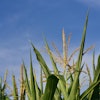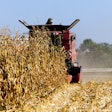
The U.S. Department of Agriculture's latest export sales report for the week of January 24-30, 2025, reveals a complex picture of the nation's agricultural trade landscape. The data highlights significant movements across key commodities, reflecting the dynamic nature of global agricultural markets.
Corn exports emerged as a bright spot, with net sales of 1,477,200 metric tons (MT) for the 2024/2025 marketing year, marking a 9% increase from the previous week and a substantial 32% rise from the prior 4-week average. Mexico led the purchases with 251,700 MT, followed closely by Japan and South Korea. This uptick in corn sales suggests strong international demand, potentially driven by favorable pricing or concerns about global supply.
In contrast, soybean exports faced headwinds, with net sales of 387,700 MT for 2024/2025 showing a 12% decrease from the previous week and a 40% drop from the prior 4-week average. China remained the top buyer with 208,700 MT, despite the overall decline. The reduction in soybean sales may indicate increased competition from other exporting nations or changes in import strategies among key buyers.
Wheat exports held relatively steady, with net sales of 438,900 MT for 2024/2025, down 4% from the previous week but up 41% from the prior 4-week average. Mexico emerged as the leading purchaser, securing 122,000 MT. The stability in wheat sales suggests a balanced global supply-demand situation, with consistent demand from traditional markets.
Notable performances were also seen in other commodities. Soybean cake and meal hit a marketing-year high with net sales of 530,600 MT for 2024/2025, up 29% from the previous week. This surge indicates strong demand for animal feed, potentially reflecting growth in global livestock production.
Cotton exports showed a mixed picture, with Upland cotton net sales of 188,900 running bales (RB) for 2024/2025, down 33% from the previous week. Turkey and Pakistan were the top buyers, suggesting continued demand from key textile-producing nations despite the overall decline.'s latest export sales report for the week of January 24-30, 2025, reveals a complex picture of the nation's agricultural trade landscape. The data highlights significant movements across key commodities, reflecting the dynamic nature of global agricultural markets.
Corn exports emerged as a bright spot, with net sales of 1,477,200 metric tons (MT) for the 2024/2025 marketing year, marking a 9% increase from the previous week and a substantial 32% rise from the prior 4-week average. Mexico led the purchases with 251,700 MT, followed closely by Japan and South Korea. This uptick in corn sales suggests strong international demand, potentially driven by favorable pricing or concerns about global supply.
In contrast, soybean exports faced headwinds, with net sales of 387,700 MT for 2024/2025 showing a 12% decrease from the previous week and a 40% drop from the prior 4-week average. China remained the top buyer with 208,700 MT, despite the overall decline. The reduction in soybean sales may indicate increased competition from other exporting nations or changes in import strategies among key buyers.
Wheat exports held relatively steady, with net sales of 438,900 MT for 2024/2025, down 4% from the previous week but up 41% from the prior 4-week average. Mexico emerged as the leading purchaser, securing 122,000 MT. The stability in wheat sales suggests a balanced global supply-demand situation, with consistent demand from traditional markets.
Notable performances were also seen in other commodities. Soybean cake and meal hit a marketing-year high with net sales of 530,600 MT for 2024/2025, up 29% from the previous week. This surge indicates strong demand for animal feed, potentially reflecting growth in global livestock production.
Cotton exports showed a mixed picture, with Upland cotton net sales of 188,900 running bales (RB) for 2024/2025, down 33% from the previous week. Turkey and Pakistan were the top buyers, suggesting continued demand from key textile-producing nations despite the overall decline.

















